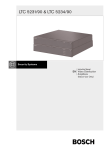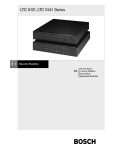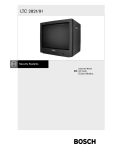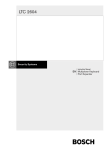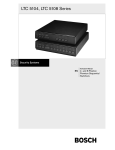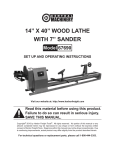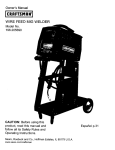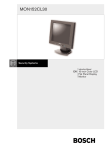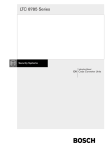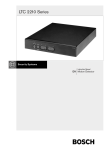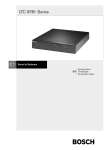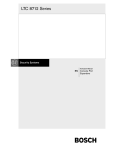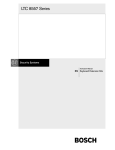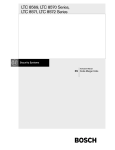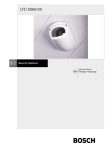Download Associated Equipment 9409 Instruction manual
Transcript
LTC 9409 Series Instruction Manual EN Weatherproof Outdoor Pan/Tilts LTC 9409 Series | Instruction Manual | Important Safeguards EN | 2 Important Safeguards 1. Read, Follow, and Retain Instructions - All safety and operating instructions should be read and followed before operating the unit. Retain instructions for future reference. 2. Heed Warnings - Adhere to all warnings on the unit and in the operating instructions. 3. Attachments - Attachments not recommended by the product manufacturer should not be used, as they may cause hazards. 4. Installation Cautions - Do not place this unit on an unstable stand, tripod, bracket, or mount. The unit may fall, causing serious injury to a person and serious damage to the unit. Use only manufacturerrecommended accessories, or those sold with the product. Mount the unit per the manufacturer's instructions. Appliance and cart combination should be moved with care. Quick stops, excessive force, or uneven surfaces may cause the appliance and cart combination to overturn. 5. Cleaning - Unplug the unit from the outlet before cleaning. Follow any instructions provided with the unit. Generally, using a damp cloth for cleaning is sufficient. Do not use liquid cleaners or aerosol cleaners. 6. Servicing - Do not attempt to service this unit yourself. Opening or removing covers may expose you to dangerous voltage or other hazards. Refer all servicing to qualified service personnel. 7. Damage Requiring Service - Unplug the unit from the main AC power source and refer servicing to qualified service personnel under the following conditions: • When the power supply cord or plug is damaged. • If liquid has been spilled or an object has fallen into the unit. • If the unit has been exposed to water and/or inclement weather (rain, snow, etc.). • If the unit does not operate normally, when following the operating instructions. Adjust only those controls specified in the operating instructions. Improper adjustment of other controls may result in damage, and require extensive work by a qualified technician to restore the unit to normal operation. • If the unit has been dropped or the cabinet damaged. • If the unit exhibits a distinct change in performance, this indicates that service is needed. 8. Replacement Parts - When replacement parts are required, the service technician should use replacement parts specified by the manufacturer or that have the same characteristics as the original part. Unauthorized substitutions may result in fire, electrical shock or other hazards. 9. Safety Check - Upon completion of servicing or repairs to the unit, ask the service technician to perform safety checks to ensure proper operating condition. Bosch Security Systems | 13 April 2004 10. Power Sources - Operate the unit only from the type of power source indicated on the label. If unsure of the type of power supply to use, contact your dealer or local power company. • For units intended to operate from battery power, refer to the operating instructions. • For units intended to operate with External Power Supplies, use only the recommended approved power supplies. • For units intended to operate with a limited power source, this power source must comply with EN60950. Substitutions may damage the unit or cause fire or shock. • For units intended to operate at 24VAC, normal input voltage is 24VAC. Voltage applied to the unit's power input should not exceed 30VAC. User-supplied wiring, from the 24VAC supply to unit, must be in compliance with electrical codes (Class 2 power levels). Do not ground the 24VAC supply at the terminals or at the unit's power supply terminals. 11. Coax Grounding - If an outside cable system is connected to the unit, ensure that the cable system is grounded. U.S.A. models only - Section 810 of the National Electrical Code, ANSI/NFPA No.70, provides information regarding proper grounding of the mount and supporting structure, grounding of the coax to a discharge unit, size of grounding conductors, location of discharge unit, connection to grounding electrodes, and requirements for the grounding electrode. 12. Grounding or Polarization - This unit may be equipped with a polarized alternating current line plug (a plug with one blade wider than the other). This safety feature allows the plug to fit into the power outlet in only one way. If unable to insert the plug fully into the outlet, try reversing the plug. If the plug still fails to fit, contact an electrician to arrange replacement of the obsolete outlet. Do not defeat the safety purpose of the polarized plug. Alternately, this unit may be equipped with a 3-wire grounding plug (a plug with a third pin, for grounding). This safety feature allows the plug to fit into a grounding power outlet only. If unable to insert the plug into the outlet, contact an electrician to arrange replacement of the obsolete outlet. Do not defeat the safety purpose of the grounding plug. 13. Lightning - For added protection during a lightning storm, or when this unit is left unattended and unused for long periods of time, unplug the unit from the wall outlet and disconnect the cable system. This will prevent damage to the unit due to lightning and power line surges. EN | 3 LTC 9409 Series | Instruction Manual | Important Safeguards For Indoor Product 1. Water and Moisture - Do not use this unit near water - for example, in a wet basement, in an unprotected outdoor installation or in any area classified as a wet location. 2. Object and Liquid Entry - Never push objects of any kind into this unit through openings, as they may touch dangerous voltage points or short out parts that could result in a fire or electrical shock. Never spill liquid of any kind on the unit. 3. Power Cord and Power Cord Protection - For units intended to operate with 230VAC, 50Hz, the input and output power cord must comply with the latest versions of IEC Publication 227 or IEC Publication 245. Power supply cords should be routed so they are not likely to be walked on or pinched. Pay particular attention to location of cords and plugs, convenience receptacles, and the point of exit from the appliance. 4. Overloading - Do not overload outlets and extension cords; this can result in a risk of fire or electrical shock. For Outdoor Product Power Lines - An outdoor system should not be located in the vicinity of overhead power lines, electric lights or power circuits, or where it may contact such power lines or circuits. When installing an outdoor system, extreme care should be taken to keep from touching power lines or circuits, as this contact might be fatal. U.S.A. models only - refer to the National Electrical Code Article 820 regarding installation of CATV systems. For Rack-mount Product 1. Ventilation - This unit should not be placed in a built-in installation or rack, unless proper ventilation is provided, or the manufacturer’s instructions have been adhered to. The equipment must not exceed its maximum operating temperature requirements. 2. Mechanical Loading - Mounting of the equipment in a rack shall be such that a hazardous condition is not achieved due to uneven mechanical loading. Bosch Security Systems | 13 April 2004 ATTENTION OBSERVE PRECAUTIONS FOR HANDLING ELECTROSTATIC SENSITIVE DEVICES WARNING: Electrostatic-sensitive device. Use proper CMOS/MOSFET handling precautions to avoid electrostatic discharge. NOTE: Grounded wrist straps must be worn and proper ESD safety precautions observed when handling the electrostaticsensitive printed circuit boards. Safety Precautions CAUTION: TO REDUCE THE RISK OF ELECTRIC SHOCK, DO NOT REMOVE COVER (OR BACK). NO USER SERVICEABLE PARTS INSIDE. REFER SERVICING TO QUALIFIED SERVICE PERSONNEL. This symbol indicates the presence of uninsulated “dangerous voltage” within the product’s enclosure. This may constitute a risk of electric shock. The user should consult the operating and maintenance (servicing) instructions in the literature accompanying the appliance. Attention: Installation should be performed by qualified service personnel only in accordance with the National Electrical Code or applicable local codes. Power Disconnect. Units with or without ON-OFF switches have power supplied to the unit whenever the power cord is inserted into the power source; however, the unit is operational only when the ON-OFF switch is in the ON position. The power cord is the main power disconnect for all units. EN | 4 LTC 9409 Series | Instruction Manual | Important Safeguards FCC & ICES INFORMATION Sicherheitshinweise (U.S.A. and Canadian Models Only) This device complies with part 15 of the FCC Rules. Operation is subject to the following two conditions: (1) This device may not cause harmful interference, and (2) This device must accept any interference received, including interference that may cause undesired operation. NOTE: This equipment has been tested and found to comply with the limits for a Class A digital device, pursuant to Part 15 of the FCC Rules and ICES-003 of Industry Canada. These limits are designed to provide reasonable protection against harmful interference when the equipment is operated in a commercial environment. This equipment generates, uses and radiates radio frequency energy, and if not installed and used in accordance with the instruction manual, may cause harmful interference to radio communications. Operation of this equipment in a residential area is likely to cause harmful interference, in which case the user will be required to correct the interference at his expense. Intentional or unintentional changes or modifications, not expressly approved by the party responsible for compliance, shall not be made. Any such changes or modifications could void the user’s authority to operate the equipment. If necessary, the user should consult the dealer or an experienced radio/television technician for corrective action. The user may find the following booklet, prepared by the Federal Communications Commission, helpful: How to Identify and Resolve Radio-TV Interference Problems. This booklet is available from the U.S. Government Printing Office, Washington, DC 20402, Stock No. 004-00000345-4. WARNING: This is a Class A product. In a domestic environment, this product may cause radio interference, in which case, the user may be required to take adequate measures. VORSICHT: UM EINEN ELEKTRISCHEN SCHLAG ZU VERMEIDEN, IST DIE ABDECKUNG (ODER RÜCKSEITE) NICHT ZU ENTFERNEN. ES BEFINDEN SICH KEINE TEILE IN DIESEM BEREICH, DIE VOM BENUTZER GEWARTET WERDEN KÖNNEN. LASSEN SIE WARTUNGSARBEITEN NUR VON QUALIFIZIERTEM WARTUNGSPERSONAL AUSFÜHREN. Das Symbol macht auf nicht isolierte „gefährliche Spannung" im Gehäuse aufmerksam. Dies kann zu einem elektrischen Schlag führen. Der Benutzer sollte sich ausführlich über Anweisungen für die Bedienung und Instandhaltung (Wartung) in den begleitenden Unterlagen informieren. Achtung! Die Installation sollte nur von qualifiziertem Kundendienstpersonal gemäß jeweils zutreffender Elektrovorschriften ausgeführt werden. Unterbrechung des Netzanschlusses. Geräte mit oder ohne Netzschalter haben Spannung am Gerät anliegen, sobald der Netzstecker in die Steckdose gesteckt wird. Das Gerät ist jedoch nur betriebsbereit, wenn der Netzschalter (EIN/AUS) auf EIN steht. Wenn das Netzkabel aus der Steckdose gezogen wird, ist die Spannungszuführung zum Gerät vollkommen unterbrochen. Precauciones de Seguridad Sécurité ATTENTION : POUR ÉVITER TOUT RISQUE D'ÉLECTROCUTION, N'ESSAYEZ PAS DE RETIRER LE CAPOT (OU LE PANNEAU ARRIÈRE). CET APPAREIL NE CONTIENT AUCUN COMPOSANT SUSCEPTIBLE D'ÊTRE RÉPARÉ PAR L'UTILISATEUR. CONFIEZ LA RÉPARATION DE L'APPAREIL À DU PERSONNEL QUALIFIÉ. PRECAUCIÓN: PARA DISMINUIR EL RIESGO DE DESCARGA ELÉCTRICA, NO RETIRE LA CUBIERTA (NI LA PARTE POSTERIOR). NO EXISTEN PIEZAS DE RECAMBIO EN EL INTERIOR DEL EQUIPO. EL PERSONAL DE SERVICIO CUALIFICADO SE ENCARGA DE REALIZAR LAS REPARACIONES. Este símbolo indica que existen puntos de tensión peligrosos sin aislamiento dentro de la cubierta de la unidad. Estos puntos pueden constituir un riesgo de descarga eléctrica. Ce symbole signale que le produit renferme une « tension potentiellement dangereuse » non isolée susceptible de provoquer une électrocution. El usuario debe consultar las instrucciones de funcionamiento y mantenimiento (reparación) en la documentación que se suministra con el aparato. Ce symbole invite l'utilisateur à consulter les instructions d'utilisation et d'entretien (dépannage) reprises dans la documentation qui accompagne l'appareil. Atención: la instalación la debe realizar únicamente personal cualificado de conformidad con el National Electric Code o las normas aplicables en su país. Attention : l'installation doit exclusivement être réalisée par du personnel qualifié, conformément au code national d'électricité américain (NEC) ou au code d'électricité local en vigueur. Desconexión de la alimentación. Las unidades con o sin interruptores de encendido/apagado reciben alimentación eléctrica siempre que el cable de alimentación esté conectado a la fuente de alimentación. Sin embargo, la unidad sólo funciona cuando el interruptor está en la posición de encendido. El cable de alimentación es la principal fuente de desconexión de todas las unidades. Coupure de l'alimentation. Qu'ils soient pourvus ou non d'un commutateur ON/OFF, tous les appareils reçoivent de l'énergie une fois le cordon branché sur la source d'alimentation. Toutefois, l'appareil ne fonctionne réellement que lorsque le commutateur est réglé sur ON. Le débranchement du cordon d'alimentation permet de couper l'alimentation des appareils. Bosch Security Systems | 13 April 2004 EN | 5 LTC 9409 Series | Instruction Manual | Importants Safeguards Veiligheidsmaatregelen VOORZICHTIG: OPEN DE BEHUIZING OF DE ACHTERKANT VAN HET APPARAAT NIET. ZO VERMINDERT U HET RISICO OP ELEKTRISCHE SCHOKKEN. IN HET APPARAAT BEVINDEN ZICH GEEN ONDERDELEN DIE U ZELF KUNT REPAREREN. LAAT SERVICE EN ONDERHOUD UITVOEREN DOOR GEKWALIFICEERD PERSONEEL. Medidas de Segurança CUIDADO: PARA REDUZIR O RISCO DE CHOQUE ELÉCTRICO, NÃO RETIRE A TAMPA (OU A PARTE POSTERIOR). NO INTERIOR, NÃO EXISTEM PEÇAS QUE POSSAM SER REPARADAS PELO UTILIZADOR. REMETA A ASSISTÊNCIA PARA OS TÉCNICOS QUALIFICADOS. Dit symbool geeft aan dat er binnen in het apparaat ongeïsoleerde, gevaarlijke spanning aanwezig is die mogelijk elektrische schokken kan veroorzaken. Este símbolo indica a presença de "tensão perigosa" não isolada dentro da estrutura do produto, o que pode constituir risco de choque eléctrico. De gebruiker dient de bedienings- en onderhoudsvoorschriften te raadplegen in de documentatie die werd meegeleverd met het apparaat. O utilizador deve consultar as instruções de funcionamento e manutenção (assistência) nos documentos que acompanham o aparelho. Attentie: het apparaat mag alleen door gekwalificeerd personeel worden geïnstalleerd. De installatie dient in overeenstemming met de nationale elektrische richtlijnen of de van toepassing zijnde lokale richtlijnen te worden uitgevoerd. Spanning uitschakelen. Apparatuur met of zonder aan-uitschakelaar staat onder spanning zolang de stekker is aangesloten op de wandcontactdoos. De apparatuur is uitsluitend in werking als de aan-uitschakelaar aan staat. Het netsnoer is de "hoofdschakelaar" voor alle apparatuur. Sicurezza ATTENZIONE: PER RIDURRE IL RISCHIO DI SCOSSE ELETTRICHE NON RIMUOVERE LA COPERTURA (O IL PANNELLO POSTERIORE). L'UNITÀ NON CONTIENE COMPONENTI INTERNI RIPARABILI DALL'UTENTE. PER QUALSIASI INTERVENTO, RIVOLGERSI A PERSONALE TECNICO QUALIFICATO. Questo simbolo indica la presenza di "tensione pericolosa" non isolata all'interno del contenitore del prodotto. Ciò comporta un potenziale rischio di scosse elettriche. Si consiglia di consultare le istruzioni operative e di manutenzione (interventi tecnici) contenute nella documentazione fornita con il dispositivo. Attenzione: l'installazione deve essere effettuata esclusivamente da personale tecnico qualificato in conformità con il National Electrical Code o con le normative locali vigenti. Scollegamento dell'alimentazione. Le unità dotate o sprovviste di interruttori ON-OFF vengono alimentate quando si inserisce il cavo nella presa dell'alimentazione. L'unità è tuttavia in funzione solo quando l'interruttore ON-OFF si trova nella posizione ON. Il cavo di alimentazione costituisce il dispositivo di scollegamento dell'alimentazione principale per tutte le unità. Bosch Security Systems | 13 April 2004 Atenção: a instalação deve ser executada apenas por técnicos qualificados da assistência, de acordo com o código eléctrico nacional ou os códigos locais aplicáveis. Corte de corrente. As unidades com ou sem interruptores ON-OFF (ligar/desligar) recebem corrente sempre que o fio de alimentação está introduzido na fonte de alimentação; contudo, a unidade apenas está operacional quando o interruptor ON-OFF está na posição ON. O fio de alimentação destina-se a desligar a corrente em todas as unidades. LTC 9409 Series | Instruction Manual | Table of Contents EN | 6 Table of Contents Important Safeguards . . . . . . . . . . . . . . . . . . . . . . . . . . . . . . . . . . . . . . . . . . . . . . . . . . . . . . . . . . . . . . . . . .2 FCC Information . . . . . . . . . . . . . . . . . . . . . . . . . . . . . . . . . . . . . . . . . . . . . . . . . . . . . . . . . . . . . . . . . . . . .4 1 UNPACKING . . . . . . . . . . . . . . . . . . . . . . . . . . . . . . . . . . . . . . . . . . . . . . . . . . . . . . . . . . . . . . . . . .7 2 SERVICE . . . . . . . . . . . . . . . . . . . . . . . . . . . . . . . . . . . . . . . . . . . . . . . . . . . . . . . . . . . . . . . . . . . . .7 3 DESCRIPTION . . . . . . . . . . . . . . . . . . . . . . . . . . . . . . . . . . . . . . . . . . . . . . . . . . . . . . . . . . . . . . . .7 4 INSTALLATION . . . . . . . . . . . . . . . . . . . . . . . . . . . . . . . . . . . . . . . . . . . . . . . . . . . . . . . . . . . . . . .7 4.1 Model Designation . . . . . . . . . . . . . . . . . . . . . . . . . . . . . . . . . . . . . . . . . . . . . . . . . . . . . . . . . . . . . . .7 4.2 Wall Mounting . . . . . . . . . . . . . . . . . . . . . . . . . . . . . . . . . . . . . . . . . . . . . . . . . . . . . . . . . . . . . . . . . .8 4.3 Electrical Connections . . . . . . . . . . . . . . . . . . . . . . . . . . . . . . . . . . . . . . . . . . . . . . . . . . . . . . . . . . . .8 4.4 Grounding Connection . . . . . . . . . . . . . . . . . . . . . . . . . . . . . . . . . . . . . . . . . . . . . . . . . . . . . . . . . . .9 4.5 Connector Assembly . . . . . . . . . . . . . . . . . . . . . . . . . . . . . . . . . . . . . . . . . . . . . . . . . . . . . . . . . . . . .9 4.6 Pan/Tilt Stops . . . . . . . . . . . . . . . . . . . . . . . . . . . . . . . . . . . . . . . . . . . . . . . . . . . . . . . . . . . . . . . . . .9 5 OPERATION . . . . . . . . . . . . . . . . . . . . . . . . . . . . . . . . . . . . . . . . . . . . . . . . . . . . . . . . . . . . . . . . . .9 5.1 Manual Pan Operation . . . . . . . . . . . . . . . . . . . . . . . . . . . . . . . . . . . . . . . . . . . . . . . . . . . . . . . . . . .9 5.2 Auto-pan Operation . . . . . . . . . . . . . . . . . . . . . . . . . . . . . . . . . . . . . . . . . . . . . . . . . . . . . . . . . . . . . .9 5.3 Pan Stop Adjustment . . . . . . . . . . . . . . . . . . . . . . . . . . . . . . . . . . . . . . . . . . . . . . . . . . . . . . . . . . . .10 5.4 Tilt Adjustments . . . . . . . . . . . . . . . . . . . . . . . . . . . . . . . . . . . . . . . . . . . . . . . . . . . . . . . . . . . . . . . .10 5.5 Pre-position Models . . . . . . . . . . . . . . . . . . . . . . . . . . . . . . . . . . . . . . . . . . . . . . . . . . . . . . . . . . . . .10 6 ILLUSTRATIONS . . . . . . . . . . . . . . . . . . . . . . . . . . . . . . . . . . . . . . . . . . . . . . . . . . . . . . . . . . . . .11 Bosch Security Systems | 13 April 2004 EN | 7 LTC 9409 Series | Instruction Manual | Unpacking 1 UNPACKING 4 INSTALLATION This electronic equipment should be unpacked and handled with care. This installation should be made by a qualified service person, and conform to all local codes. Check for the following items: Always disconnect power to the unit at the controller prior to connecting or disconnecting pan/tilt electrical connector. Pan/tilt is to be mounted away from unauthorized access [3m (10ft) high minimum]. • Model number of unit If an item appears to have been damaged in shipment, replace it properly in its carton and notify the shipper. If any items are missing, notify your Bosch Security Systems Inc. Sales Representative or Customer Service. The LTC 9409 Series units are designed for either upright or inverted installations. To maintain weatherproof integrity when mounting outdoors in an inverted position, the unit must be installed in a weatherproof enclosure (e.g., weatherproof domed housing) or a protected outside area. The shipping carton is the safest container in which the unit may be transported. Save it for possible future use. 2 SERVICE If the unit ever needs repair service, the customer should contact the nearest Bosch Security Systems Inc. Service Center for authorization to return and shipping instructions. Service Centers USA Phone: 800-366-2283 or 717-735-6638 fax: 800-366-1329 or 717-735-6639 CCTV Spare Parts Phone: 800-894-5215 or 408-956-3853 or 3854 fax: 408-957-3198 e-mail: [email protected] Canada Phone: 514-738-2434 Europe, Middle East & Asia Pacific Region Phone: 32-1-440-0711 For additional information, see www.boschsecuritysystems.com. 3 Pan/tilts and associated equipment should be tested prior to field installation to verify proper wiring and operation of components. The combined weight of the enclosure/camera/lens should be centered equally, front to back, on the tilt table surface for best pan/tilt operation. 4.1 Model No. 1 Bosch Security Systems | 13 April 2004 Rated Motor Voltage Operational Range Total Pan Angle (No fixed Stop) LTC 9409/60 115VAC, 60Hz 103 to 126 150 to 3550 LTC 9409/20 24VAC, 60Hz 21.6 to 26.4 150 to 3550 LTC 9409/10 24VAC, 50Hz 21.6 to 26.4 150 to 3550 LTC 9409/502 230VAC, 50Hz 198 to 265 150 to 3550 LTC 9409/61 115VAC, 60Hz 103 to 126 150 to 3550 LTC 9409/21 24VAC, 60Hz 21.6 to 26.4 150 to 3550 LTC 9409/11 24VAC, 50Hz 21.6 to 26.4 150 to 3550 LTC 9409/51 230VAC, 50Hz 198 to 265 150 to 3550 Standard Models Pre-position Models DESCRIPTION The LTC 9409 Series Weatherproof Outdoor Pan/Tilts are low profile, economical, compact units constructed with corrosion-resistant hardware. These remote positioning devices are fully system compatible with CCD cameras, lenses, and housing combinations. Model Designation 1 The total power for all models, with both motors running, is 18W. 2 Single phase power sources only. Do not exceed 30VAC on 24VAC models. Operation above 30VAC violates low voltage operation (Class 2 Specifications). Normal operation is 24VAC. EN | 8 LTC 9409 Series | Instruction Manual | Installation 4.1.1 Recommended Controls LTC 5133 and LTC 5134 Series Desktop Pan/Tilt/Lens control via hardwired connections LTC 8561 and LTC 8566 Series Remote Receiver/Driver for a balanced line system. For use with LTC 8500 Series, LTC 8600 Series, LTC 8800 Series, and LTC 5135 Series Systems 4.3 Electrical Connections 1. Cable must be wired according to Connector Assembly and Recommended Maximum Cable Lengths. 2. Use separate shielded cables for camera power, enclosure power, and pan/tilt control. Combining lens control wiring and video coax within a common cable is acceptable if required. The use of a common multiconductor cable to combine all functions is not recommended. Using a shielded cable is recommended for pre-position wiring. 3. Use color-coded conductors to aid in wiring and future identification. 4. Retain the wiring diagram for later reference. 4.1.2 Recommended Mounting Equipment LTC 9216/00 LTC 9222/00 LTC 9214/00 4.2 Medium duty wall mount, designed to support up to 45.3kg (100lb) Heavy duty wall mount, designed to support up to 90.6kg (200lb) Heavy duty column mount, for ceiling or pedestal use 4.3.1 Recommended Maximum Cable Lengths 1 Model Wire Size Voltage mm2 AWG Meters Feet 24VAC 0.5 20 58 190 1 18 91 300 1.5 16 145 475 2.5 14 236 775 4 12 381 1250 0.5 20 1402 4600 1 18 2256 7400 1.5 16 3537 11600 2.5 14 5762 18900 4 12 9146 30000 6 10 14146 46600 0.5 20 7622 25000 1 18 12043 39500 1.5 16 18172 59600 2.5 14 30701 100700 4 12 48872 160300 Wall Mounting Follow the instructions provided with the mounts. The mount and mounting surface must be able to support the weight of the pan/tilt, camera/lens, and enclosure (if used). The camera/lens/enclosure must be properly mounted and balanced on the pan/tilt bracket. CAUTION: The LTC 9409 Series pan/tilts are to be mounted upright or inverted, never horizontally 115VAC 230VAC Mount the camera/lens/enclosure to the pan/tilt bracket as follows: 1. Mount the camera/lens/enclosure, in either of the two sets of slots. (Dome mounting: Use the set of slots centered on the pan/tilt mounting base.) 2. Balance the camera/lens/enclosure on the camera bracket, adjusting align with the mounting holes. Fasten with a minimum of two (2) 1/4-20 x 1/2-in. long fasteners and lock washers. 3. Make all electrical connections leaving sufficient cable between camera/enclosure and pan/tilt to allow for tilting and panning. Bosch Security Systems | 13 April 2004 Distance 1 Values are calculated at 200C (680F) using stranded tinned copper wire, a single conductor Pan/Tilt common (neutral) wire, and with both PAN and TILT motors operating simultaneously. EN | 9 LTC 9409 Series | Instruction Manual | Operation 4.4 Grounding Connection Grounding is provided via pin 7 on the Power Connector (P1). See Wiring Instructions and Wiring Diagram. 4.5 Connector Assembly Included with the unit are a mating connector and a sealing boot or strain relief. Solder connections are required. Make the electrical connection as shown in Wiring Instructions. The upper pan stop controls the pan left limit and the lower pan stop controls the pan right limit. The left tilt stop controls the tilt down limit, and the right tilt stop controls the tilt up. CAUTION: Disconnect P1 (Power Connector) when making any adjustments to the pan or tilt stops. Tilt Down Limit Switch Tilt Up Limit Stop 4.5.1 Wiring Instructions Power Connector (P1) Pin4 Connection2 1 Common (White) 2 Pan Left (CCW) (Black) 3 Pan Right (CW) (Brown) 4 Tilt up (Blue) 5 Tilt Down (Red) 6 NC1 7 Ground (Green/Yellow) Pan Right Limit Stop Pan Left Limit Stop Power Connector (P2)3 Pin4 Connection2 1 PP supply (+5 VDC) (Orange) 2 Pan Position (Yellow) 3 PP Return (–5 VDC) (Green) 4 Tilt Position (Grey) 5 NC1 6 NC1 7 NC1 Notes: W9412401AE Figure 1 Pan and Tilt Stop Locations 5 5.1 OPERATION Manual Pan Operation The pan stops establish the limits for manual pan. The maximum pan range is when the limit switches are contacting each other. 1 NC – No Connection; do not use 2 Color codes indicate wiring harness colors inside the unit 3 P2 not found on non pre-position models 4 Pin numbers are molded into the connector 4.6 Pan/Tilt Stops To access the pan and tilt stops, remove the rear cover from the unit. Remove the cover by removing the four Phillips head screws and pulling the cover outward. The pan and tilt stops on this unit are hand-adjustable. No tightening or loosening of fasteners (other than cover removal) is required. The stops are located on the gear motor output shafts near the printed circuit boards. Adjustment of the stops can be made by handturning the stops or by using a small screw driver. Bosch Security Systems | 13 April 2004 5.2 Auto-pan Operation The auto-pan function requires connection of the unit to a pan/tilt controller equipped with special current sensing circuitry. Auto-pan is achieved by the controller unit sensing changes in current flow through the pan motor. When a stop is reached, current flow stops, and the internal circuitry in the controller reverses the auto-pan direction. NOTE: The pan/tilt unit must be properly wired for the function to operate correctly (see Wiring Instructions). EN | 10 LTC 9409 Series | Instruction Manual | Operation 5.3 Pan Stop Adjustment 1. Adjust the pan/tilt unit into a direction approximately in the center of the area to be panned. 2. Adjust the upper and lower pan stops until they contact and are opposite the limit switches. 3. Pan the unit left to the desired maximum location. Adjust the upper pan stop CCW until contact with the switch is made. 4. Pan the unit right to the desired maximum location. Adjust the lower pan stop CW until contact with the switch is made. 5. Operate the unit from the controller to confirm that the limits are set properly. Readjust if required. 5.4 Tilt Adjustments 1. Adjust the tilt stops until both stops contact the stop pin on the tilt gear motor output shaft. 2. Tilt the unit down to the desired maximum location. Adjust the left tilt stop CCW until contact is made with the limit switch. If the camera bracket blocks access to the opening at both the up and down limit, contact Bosch Security Systems Technical Support for futher instructions. 5.5 Pre-position Models The models with pre-position capability (P suffix) require connection of the Position Connector (P2) to a controller or receiver/driver with the pre-position function (see Wiring Instructions). Pan/tilt operation and limit stop adjustment function as previously described. Upon installation, if the unit has an open circuit across the pan potentiometer in the pan range (as measured across P2, pins 1 and 2), the unit requires a potentiometer Dead Zone adjustment, as follows 1. Pan the unit to the left pan stop. 2. Disconnect P1 and P2. 3. Remove the rear cover and locate the pan potentiometer. Loosen the nut on the underside of the potentiometer support so the potentiometer can be rotated. 4. Locate the Dead Zone by rotating the potentiometer CW or CCW and measuring the resistance across P2, pin 1 and pin 2. The Dead Zone is measured as an open circuit. Do not rotate the potentiometer more than 1800 CW or 1800 CCW from the original position. 3. Tilt the unit up to the desired maximum location. Adjust the right tilt stop CW until contact is made with the limit switch. 4. Operate the unit from the controller to confirm that the limits are set properly. Readjust if required. 5. NOTE: The camera mounting bracket may inhibit access to the up tilt stop. Use the following procedure to adjust the stop: With the potentiometer in the Dead Zone, rotate the potentiometer CW until a resistive value is measured across P2, pins 1 and 2. 6. Tighten the potentiometer nut. Replace the cover and reconnect P1 and P2. 1. Perform Steps 1 and 2 under Tilt Adjustments. 2. Adjust the up tilt stop slightly to a location near the desired stopping point. 3. Tilt the unit up to the stop and observe the results. Tilt the down. 4. If a higher tilt stopping point is needed, adjust the right tilt stop CCW. If a lower tilt stopping point is needed, adjust the right tilt stop CW. 5. Repeat Steps 3 and 4 until the desired location is obtained. Bosch Security Systems | 13 April 2004 EN | 11 LTC 9409 Series | Instruction Manual | Illustrations 6 ILLUSTRATIONS 25 1.0 ø 9.5 max. ø 0.38 max. 5 0.2 5 0.2 To ensure water-tight seal, hand-tighten connectors, +1/4 turn mm in 20 0.8 Figure 4 Connector Assembly S 9506406B F Pan Potentiometer W9412402ae Figure 2 Pan Potentiometer Location 76 3.0 169 6.6 Power Connector (P1) 7 0.28 +5 VDC Pan Wiper -5 VDC Tilt Wiper No Connection No Connection No Connection P2-1 P2-2 P2-3 P2-4 P2-5 P2-6 P2-7 Black Green White Green P1 R2 1 Pan Potentiometer 2 3 Positioning Connector (P2) (-P Units Only) R1 PCB1 (PAN) Blue J3 19 0.75 P1-1 P1-2 P1-3 P1-4 P1-5 P1-6 P1-7 White Black Brown Blue Red M1 1 J1 Common Pan CCW Pan CW Tilt Up Tilt Down No Connection Gnd 10 0.38 1 2 1 Blue 2 S1 2 3 3 Black 4 3 V1 Pan Motor Red C1 S2 Grn/Yel 1 2 3 V2 67 2.6 P2 198 7.8 Tilt Potentiometer 1 2 3 PCB2 (TILT) Blue J3 M2 1 J1 37 1.5 1 S1 1 Blue 2 2 3 2 3 4 149 5.9 Black 4 V1 Red 8 0.32 S2 1 2 4 V2 ø 121 4.75 W9412403BF ø 102 4.00 mm in W9412400AE Figure 3 Dimensional Outline Bosch Security Systems | 13 April 2004 Figure 5 Wiring Diagram Tilt Motor Bosch Security Systems, Inc. 850 Greenfield Road Lancaster, PA 17601 USA Tel: 800-326-3270 Fax: 1-717-735-6560 www.boschsecuritysystems.com Bosch Security Systems B.V. P.O. Box 80002 5600 JB Eindhoven The Netherlands Tele +31 40 27 80000 © 2004 Bosch Security Systems GmbH 3935 890 07712 04-18 | April 29, 2004 | Data subject to change without notice. Bosch Security Systems Pte Ltd. 38C Jalan Pemimpin Singapore 577180 Republic of Singapore Tel: 65 (6) 319 3486












